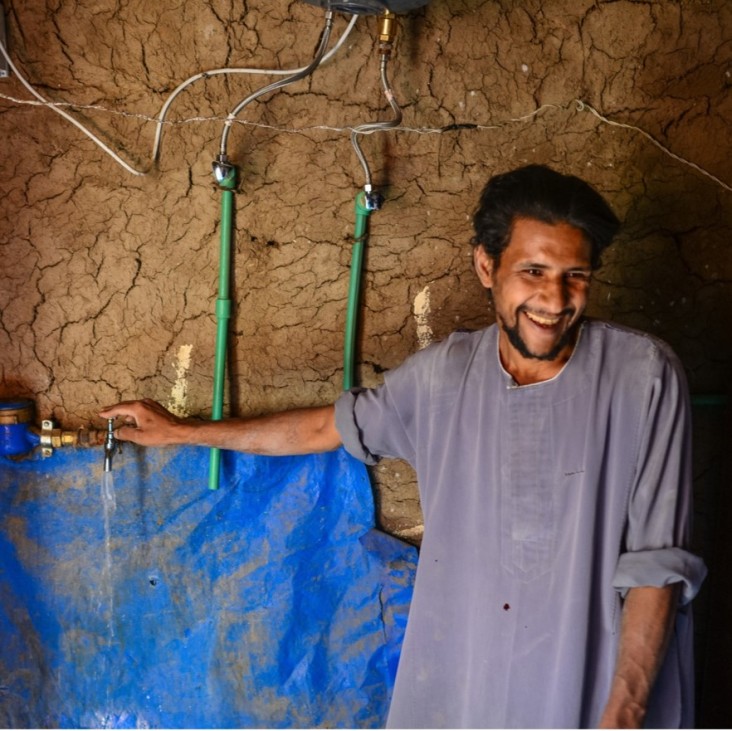
Overview
When USAID first arrived in Egypt in the late 1970s, poor water quality, pollution, and over-extended sanitation facilities had become a serious public health hazard – particularly in urban areas where diseases such as eye infections, diarrhea, fever, and rheumatism linked to daily contact with sewage were rampant. Over the next 35 years, USAID invested more than $3.5 billion to help bring potable water and sanitation services to over 25 million Egyptians, directly improving their health and environmental conditions.
1980s
USAID initially targeted construction and rehabilitation of wastewater systems in Cairo, Alexandria, and the three Suez Canal Cities. In Cairo, USAID funded a $727 million project from 1984-2006 to improve wastewater collection, treatment, and disposal on the West Bank of Cairo. A high level of saline and contaminated groundwater, due to leaking sewers and the regional influence of irrigation practices on the water table, threatened the structural integrity of several buildings and historic momunents in this area. After lowering the groundwater table to safe levels, USAID installed new and improved sewerage services that benefit hundreds of thousands of citizens in some of the poorest and most densely populated areas of central Cairo – and allowed commerce to grow.
USAID funded the installation of an entire piped sewage collection network in Alexandria that eliminated untreated sewage from Alexandria’s streets and Mediterranean Sea beaches. As a result, infant mortality rates and waterborne diseases dropped by 80 percent. Built in the late 1980s, the construction and rehabilitation of seven pump stations and the two major wastewater treatment plants in Alexandria anticipated projected population growth until 2010 – these plants continue to function, but increased population has put a strain on these facilities.
1990s
In the early 1990s, USAID focused on smaller cities in the Delta, South Sinai, and Upper Egypt. Construction of over 30 water treatment and wastewater facilities in Fayoum, Beni Suef, and Minya governorates were constructed to benefit more than three million people. However, given the downward trend in fertility rates at the time, the systems did not anticipate such rapid population growth – there are now nearly 11 million people living in those three governorates.
USAID shifted focus in the late 1990s from water construction activities to institutional and policy reforms, with cost recovery efforts as the centerpiece. In 2004, USAID helped the Government of Egypt establish the Holding Company for Water and Wastewater (HCWW), a national umbrella organization to standardize and govern local water utilitity companies, as well as the Egyptian Water Regulatory Authority. USAID also launched a program to strengthen the policy, legal, and regulatory framework for water distribution and access. By 2011, eleven of HCWW’s 24 subsidiaries have been able to achieve cost recovery for operations and maintenance and the others have made great strides toward sustainability and self-sufficiency – as well as improving operating efficiencies, billing, and collection systems. Recently, in a major breakthrough supported by USAID, Egypt’s Cabinet approved a tariff structure for the water sector that will allow HCWW to achieve operations and maintenance cost recovery in less than five years, and full cost recovery and sustainability in ten.
2000s
With reforms in place, USAID is focusing again on increasing access to clean water and sanitation services in underserved rural areas. These residents suffer from unreliable and sometimes low quality potable water service and lack of wastewater connections and treatment. Water pollution in canals and drains still represents the greatest threat to public health in these villages, as wastewater is discharged without treatment to agricultural drains and canals and carries the risk of waterborne disease. Further, population growth has led to an expansion of settlements over the heavily polluted, unsanitary waterways, putting villagers further at risk.
USAID efforts will improve access to services for 650,000 residents in these areas – services that are essential to the health of the residents and the economy of Upper Egypt. Not only do better water and wastewater services and facilities contribute to improvements in tourism, trade, and investment, but they also create thousands of job opportunities for day laborers to construct facilities. For instance, in the Baheeg community in Assiut Governorate, USAID worked directly with the local municipal water and wastewater holding company to construct a $2.6 million slow sand filter treatment plant with the capacity to supply 10,000 households (50,000 persons) with potable water. An additional $150,000 was used to fund the installation of a distribution pipeline to tie the Baheeg community to the plant using local unskilled labor and provided 1,700 person-days of local employment.
Current Activities
North Sinai Initiative: This project increases access to potable water and improves sanitation for residents in the restive North Sinai area, where access to clean water and sanitation services is scarce. Water access and infrastructure is improved through the drilling of deep wells; construction of desalination plants, potable water transmission and distribution lines, and water reservoirs; as well as procurement of water distribution trucks. Implementing Partner: HCWW; Life of Project: October1, 2014-September 30, 2017; Total Estimated Cost: $50 million; Bilateral Agreement: North Sinai Initiative.
Egypt Utilities Management: This program improves access to water and sanitation in underserved communities of rural Upper Egypt, including Beni Suef, Assiut, Sohag, Luxor, and Aswan, by providing access to safe water, constructing wastewater facilities for basic sanitation, and supporting water and sanitation policy and governance. Implementing Partner: HCWW; Life of Project: October 1, 2014-June 30, 2019; Total Estimated Cost: $30 million; Bilateral Agreement: Egypt Utilities Management.








Comment
Make a general inquiry or suggest an improvement.